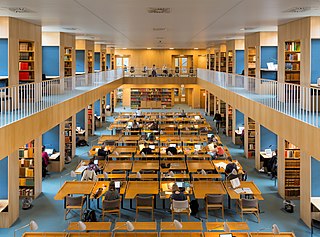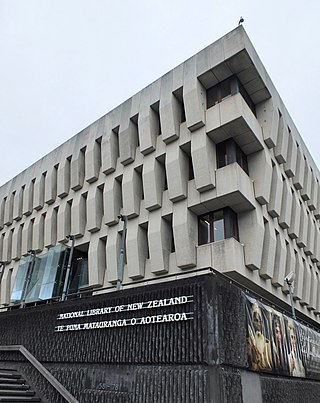
A library is a collection of books, and possibly other materials and media, that is accessible for use by its members and members of allied institutions. Libraries provide physical or digital materials, and may be a physical location, a virtual space, or both. A library's collection normally includes printed materials which may be borrowed, and usually also includes a reference section of publications which may only be utilized inside the premises. Resources such as commercial releases of films, television programmes, other video recordings, radio, music and audio recordings may be available in many formats. These include DVDs, Blu-rays, CDs, cassettes, or other applicable formats such as microform. They may also provide access to information, music or other content held on bibliographic databases.
Interlibrary loan is a service that enables patrons of one library to borrow physical materials and receive electronic documents that are held by another library. The service expands library patrons' access to resources beyond their local library's holdings, serving as "an integral element of collection development" for libraries.

This page is a glossary of library and information science.

A librarian is a person who works professionally in a library providing access to information, and sometimes social or technical programming, or instruction on information literacy to users.

The National Library of New Zealand is charged with the obligation to "enrich the cultural and economic life of New Zealand and its interchanges with other nations". Under the Act, the library's duties include collecting, preserving and protecting New Zealand's documentary heritage, supporting other libraries in New Zealand, and collaborating with peer institutions abroad. The library headquarters is on the corner of Aitken and Molesworth Streets in Wellington, close to the New Zealand Parliament Buildings and the Court of Appeal.
The Association of College and Research Libraries defines information literacy as a "set of integrated abilities encompassing the reflective discovery of information, the understanding of how information is produced and valued and the use of information in creating new knowledge and participating ethically in communities of learning". In the United Kingdom, the Chartered Institute of Library and Information Professionals' definition also makes reference to knowing both "when" and "why" information is needed.
The International Federation of Library Associations and Institutions (IFLA) is an international body representing the interests of people who rely on libraries and information professionals. A non-governmental, not-for-profit organization, IFLA was founded in Scotland in 1927 with headquarters at the National Library of the Netherlands in The Hague. IFLA sponsors the annual IFLA World Library and Information Congress, promoting access to information, ideas, and works of imagination for social, educational, cultural, democratic, and economic empowerment. IFLA also produces several publications, including IFLA Journal.
The Master of Library and Information Science (MLIS), also referred to as the Master of Library and Information Studies, is the master's degree that is required for most professional librarian positions in the United States. The MLIS is a relatively recent degree; an older and still common degree designation for librarians to acquire is the Master of Library Science (MLS), or Master of Science in Library Science (MSLS) degree. According to the American Library Association (ALA), "The master’s degree in library and information studies is frequently referred to as the MLS; however, ALA-accredited degrees have various names such as Master of Information Studies, Master of Arts, Master of Librarianship, Master of Library and Information Studies, or Master of Science. The degree name is determined by the program. The [ALA] Committee for Accreditation evaluates programs based on their adherence to the Standards for Accreditation of Master's Programs in Library and Information Studies, not based on the name of the degree."
Library technical services are the ongoing maintenance activities of a library's collection, including the three broad areas of collection development, cataloging, and processing. Technical services are the infrastructure that enable the user's experience of many library services and are typically performed "behind the scenes."
Library acquisitions is the department of a library responsible for the selection and purchase of materials or resources. The department may select vendors, negotiate consortium pricing, arrange for standing orders, and select individual titles or resources.
Knowledge organization (KO), organization of knowledge, organization of information, or information organization, is an intellectual discipline concerned with activities such as document description, indexing, and classification that serve to provide systems of representation and order for knowledge and information objects. According to The Organization of Information by Joudrey and Taylor, information organization:
examines the activities carried out and tools used by people who work in places that accumulate information resources for the use of humankind, both immediately and for posterity. It discusses the processes that are in place to make resources findable, whether someone is searching for a single known item or is browsing through hundreds of resources just hoping to discover something useful. Information organization supports a myriad of information-seeking scenarios.
In archival science and archive administration, appraisal is a process usually conducted by members of the record-holding institution in which a body of records is examined to determine its value for that institution. It also involves determining how long this value will last. The activity is one of the central tasks of an archivist, to determine the archival value of specific records. When it occurs prior to acquisition, the appraisal process involves assessing records for inclusion in the archives. In connection with an institution's collecting policy, appraisal "represents a doorway into the archives through which all records must pass". Some considerations when conducting appraisal include how to meet the record-granting body's organizational needs, how to uphold requirements of organizational accountability, and how to meet the expectations of the record-using community.
The National Library and Information System of Trinidad and Tobago is a corporate body established by the NALIS Act No. 18 of 1998 to administer the development and coordination of library and information services in Trinidad and Tobago.
Electronic resource management (ERM) is the practices and techniques used by librarians and library staff to track the selection, acquisition, licensing, access, maintenance, usage, evaluation, retention, and de-selection of a library's electronic information resources. These resources include, but are not limited to, electronic journals, electronic books, streaming media, databases, datasets, CD-ROMs, and computer software.
The Association for Library Collections and Technical Services (ALCTS) was a division of the American Library Association (ALA) dedicated to the areas of technical services, collection management and development, and preservation and reformatting. ALCTS membership represented over forty countries and included librarians, library support staff, students of library and information science, and commercial vendors whose professional interests lay in these areas of practice. ALCTS met the needs of its members through educational programming, publications, professional development opportunities and information exchange. ALCTS also promoted and had significant input into the development of standards and best practices, including NISO standards and cataloging standards such as RDA.
In the context of libraries and archives, an inventory refers to a detailed list or record of the items, materials, or resources held within a collection.
Ben Gu is a librarian, translator and library science researcher. He received his M.S. degree in Mathematics in Fudan University in 1987, and got his Ph.D. degree in Information Science in Renmin University of China in 2000. He translated many scholarly works in musicology, philosophy, history and library science, and compiled several books in library acquisitions and library cataloging. He was awarded by the State Council for his special contributions in library science.

Collections management involves the development, storage, and preservation of cultural property, as well as objects of contemporary culture in museums, libraries, archives and private collections. The primary goal of collections management is to meet the needs of the individual collector or collecting institution's mission statement, while also ensuring the long-term safety and sustainability of the cultural objects within the collector's care. Collections management, which consists primarily of the administrative responsibilities associated with collection development, is closely related to collections care, which is the physical preservation of cultural heritage. The professionals most influenced by collections management include collection managers, registrars, and archivists.

Weeding is systematically removing resources from a library based on selected criteria. It is the opposite of selecting material for incorporation, though the selection and de-selection of material often involve the same thought process. Weeding is a vital process for an active collection because it ensures it stays current, relevant, and in good condition. Weeding should be continuous. Educating the staff with workshops and presentations on collection quality, maintenance, and the importance and positive benefits of weeding the collection are important components for a library to consider.
Indigenous librarianship is a distinct field of librarianship that brings Indigenous approaches to areas such as knowledge organization, collection development, library and information services, language and cultural practices, and education. The Encyclopedia of Library and Information Sciences states that Indigenous librarianship emerged as a "distinct field of practice and an arena for international scholarship in the late twentieth century bolstered by a global recognition of the value and vulnerability of Indigenous knowledge systems, and of the right of Indigenous peoples to control them."





